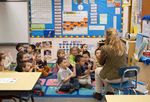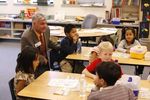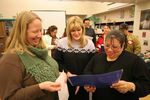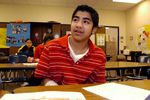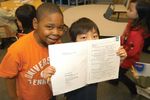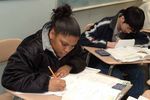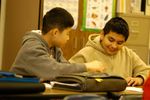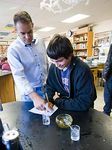Culturally Responsive Teaching - A Guide to Evidence-Based Practices for Teaching All Students Equitably - Education Northwest
←
→
Page content transcription
If your browser does not render page correctly, please read the page content below
Culturally
Responsive
Teaching A Guide to Evidence-Based
Practices for Teaching All
Students EquitablyAbout the Region X Equity Assistance Center The Region X Equity Assistance Center (EAC) at Education Northwest helps schools and their communities incorporate educational equity into policies, procedures, and classroom practices to ensure that all students receive what they need to succeed academically. Our principal responsibilities are to provide and support planning, implementation, and sustainability for equity initiatives at the request of school boards and other responsible governmental agencies. We work with our stakeholders to increase family and community engagement, improve student academic performance, and strengthen student engagement and school culture. We also provide assistance with culturally responsive teaching, school safety, and compliance with the requirements of the federal Dear Colleague Letters. As one of 10 centers funded by the U.S. Department of Education, we provide training and technical assistance to K–12 public schools within Region X at no cost or through a cost-share arrangement. Region X consists of Alaska, Hawaii, Idaho, Oregon, Washington, Territory of American Samoa, Commonwealth of the Northern Mariana Islands, Territory of Guam, Federated States of Micronesia (Chuuk, Kosrae, Pohnpei, Yap), Republic of the Marshall Islands, and Republic of Palau. For more information or to request assistance, go to: http://educationnorthwest.org/equity-assistance-center/ Contact Dr. Yvonne Ryans, Director, Region X Equity Assistance Center at Education Northwest 101 S.W. Main Street, Suite 500, Portland, Oregon 97204 Phone: 503.275.9481 (toll free: 800.547.6339) Yvonne.Ryans@educationnorthwest.org Discrimination Prohibited No person in the United States shall, on the grounds of race, national origin, sex, or disability, be excluded from participation in, be denied the benefits of, or be subjected to discrimination under any program or activity receiving federal financial assistance, or be so treated on the basis of sex under most education programs or activities receiving federal financial assistance. About This Publication This publication is based on work supported wholly or in part by grant number S004D60006 and S004D990005 from the U.S. Department of Education. The content of this document does not necessarily reflect the views of the department or any other agency of the United States government. Permission is hereby granted to reproduce this publication in whole or in part with the acknowledgment of the Region X Equity Assistance Center at Education Northwest as the source.
Region X
Equity
Assistance
Center
at Education Northwest
Culturally
Responsive
Teaching
A Guide to Evidence-Based Practices
for Teaching All Students Equitably
March 2016
Basha Krasnoff
Region X Equity Assistance Center
Education NorthwestContents Introduction . . . . . . . . . . . . . . . . . . . . . . . . . . . . . . . . . . . . . . . 1 Preparing Teachers to Be Culturally Responsive . . . . . . . . . . . . . . . . . . . 2 Effective Teaching is Culturally Responsive . . . . . . . . . . . . . . . . . . . . . . 3 Teacher Expectations and Student Achievement . . . . . . . . . . . . . . . . . . . 4 Teacher Skills and Student Success . . . . . . . . . . . . . . . . . . . . . . . . . . 8 Teacher Caring and Community Building . . . . . . . . . . . . . . . . . . . . . . 9 Teachers Cultivating Cross-Cultural Communication. . . . . . . . . . . . . . . . 10 Considering Cultural Diversity when Designing Instruction . . . . . . . . . . . . 12 Teachers Recognizing Key Dimensions of Cultural Learning Diversity. . . . . . . 14 Teachers Creating an Equitable Classroom Climate . . . . . . . . . . . . . . . . . 16 Conclusion. . . . . . . . . . . . . . . . . . . . . . . . . . . . . . . . . . . . . . . . 18 Limitations. . . . . . . . . . . . . . . . . . . . . . . . . . . . . . . . . . . . . . . . 20 Appendix A: Educational Equity . . . . . . . . . . . . . . . . . . . . . . . . . . . . 21 Appendix B: Considerations Beyond the Classroom. . . . . . . . . . . . . . . . . 23 References . . . . . . . . . . . . . . . . . . . . . . . . . . . . . . . . . . . . . . . . 25
Introduction
Students in the United States and its territories come • Decrease dependence on packaged instructional
from a large and increasing number of racially, materials and increase implementation of strategies
ethnically, culturally, and linguistically diverse and techniques targeted to the needs of specific
families: diverse students made up 48 percent of student groups
the population in 2011, up from 39 percent in 2001.
• Integrate the use of technology into instructional
Teachers and school leaders, for the most part, do not
practice to bridge the generational divide
reflect that diversity (U.S. Department of Education
Equity and Excellence Commission, 2013). In 2012, • Recruit and retain high-quality teachers for schools
84 percent of full-time public school teachers were in rural and remote areas
White, 7 percent were Black, 7 percent were Hispanic,
and fewer than 2 percent were Asian or Pacific Addressing the unique needs of students from diverse
Islander (Aud et al., 2013). backgrounds is one of the major challenges facing
public education today because many teachers are
The contrast in the demographic composition of inadequately prepared with the relevant content
educators and their students is cause for concern knowledge, experience, and training (Au, 2009;
because research shows that students’ race, ethnicity, Cummins, 2007). Inadequate preparation can create
and cultural background significantly influence a cultural gap between teachers and students (Gay,
their achievement. (Harry & Klingner, 2006; Orosco 2010; Ladson-Billings, 2009) that limits the ability of
& Klingner, 2010; Skiba et al., 2011). There is educators to choose effective instructional practices
extensive evidence from achievement test scores, and curricular materials. Research on curriculum
grade promotion rates, graduation rates, and other and instructional practices has primarily focused on
common indicators of school success that students White middle-class students, while virtually ignoring
from culturally and linguistically diverse backgrounds the cultural and linguistic characteristics of diverse
experience poorer educational outcomes than their learners (Orosco, 2010; Orosco & O’Connor, 2011).
peers (Bennett et al., 2004; Conchas & Noguera, 2004;
Sanders, 2000). Additional factors such as poverty A mandate for change requires that racially, ethnically,
and inadequate training or professional development culturally, and linguistically diverse students have
opportunities for teachers compound this negative the opportunity to meet their learning challenges
impact, as do systemic issues like biased assessment with the strength and relevance found in their own
practices and institutional racism. cultural frame of reference. Therefore, teachers must
be prepared with a thorough understanding of the
According to Scott (2000), if the essential intention specific cultures of the students they teach; how
of education is to positively impact students’ lives by that culture affects student learning behaviors; and
equipping them with critical knowledge and skills how they can change classroom interactions and
through culturally relevant, expert practice, then instruction to embrace the differences.
disparities in curriculum and instruction require that
school districts shift their priorities and policies. Scott
suggests that districts:
• Require each teacher to obtain proper certification,
training, and professional development
• Increase teacher motivation to recognize diverse
learners’ strengths, as well as their needs
Culturally Responsive Teaching 1Preparing Teachers To Be Culturally Responsive
Because culture strongly influences the attitudes, 1. Socio-cultural consciousness: A teacher’s
values, and behaviors that students and teachers own way of thinking, behaving, and being are
bring to the instructional process, better teacher influenced by race, ethnicity, social class, and
preparation is a major factor in solving the problems language. Prospective teachers must critically
of underachievement. Reasonably, teachers can only examine their own socio-cultural identities and
be held accountable for student outcomes if they are biases in the context of the inequalities culturally
adequately prepared to be culturally responsive to diverse segments of society experience. They must
their students’ learning styles and needs. recognize discrimination based on ethnicity, social
class, and skin color and inspect and confront any
Seminal studies of culturally responsive teaching, negative attitudes they might have toward diverse
conducted over the course of the past 30–40 years student groups.
have provided the evidence base for many of the
2. Attitude: A teacher’s affirming attitude toward
innovative practices developed by Geneva Gay, Sonia
students from culturally diverse backgrounds
Nieto, and Gloria Ladson-Billings. These “teachers
significantly impacts student learning, belief in
of teachers“ developed systems of instructional
themselves, and overall academic performance. By
delivery based on what the research told them about
respecting cultural differences and using curricular
racially, ethnically, culturally, and linguistically
and instructional practices related to the cultures
diverse students. For them, cultural congruity had
of their students, schools and classrooms become
to be deeply embedded in any teaching practice;
inclusive.
therefore, they recommended training teachers in
instructional techniques matched to the diverse 3. Commitment and skills: A teacher’s role as an
learning styles of their students. Gay (2002) made the agent of change confronts barriers/obstacles to
case for preparing teachers with culturally responsive those changes and develops skills for collaboration.
knowledge, attitudes, and skills during preservice As agents of change, teachers assist schools in
education programs to improve the school success of becoming more equitable over time.
diverse students. Through proper training, teachers
4. Constructivist views: A teacher’s contention
learn to bridge the gap between instructional delivery
that all students are capable of learning requires
and diverse learning styles and establish continuity
building scaffolding between what students already
between how diverse students learn and communicate
know through their own experiences and what they
and how the school approaches teaching and learning.
need to learn. Constructivist teaching promotes
critical thinking, problem solving, collaboration,
Villegas and Lucas (2002) encouraged teacher
and the recognition of multiple perspectives.
educators to critically examine their programs and
systematically interweave throughout prospective 5. Knowledge of student’s life: A teacher’s learning
teachers’ coursework, learning experiences, and about a student’s past experiences, home and
fieldwork the strategies that research has shown community culture, and world in and out of school
better prepares them to work successfully with helps build relationships by increasing the use of
diverse students. These researchers posited that these experiences in the context of teaching and
helping prospective teachers develop the following six learning.
characteristics would prepare them to be culturally
6. Culturally responsive teaching: A teacher’s use
responsive.
of strategies that support a constructivist view of
knowledge, teaching, and learning assists students
in constructing knowledge, building on their
personal and cultural strengths, and examining
the curriculum from multiple perspectives, thus
creating an inclusive classroom environment.
2 © Education Northwest 2016Effective Teaching Is Culturally Responsive
Researchers at the Comprehensive Center for Teacher 3. Use diverse resources to plan and structure
Quality (Goe, Bell, & Little, 2008) concluded that engaging learning opportunities, monitor student
being an effective teacher means more than providing progress formatively, adapt instruction as needed,
subject-matter instruction or focusing on one and evaluate learning using multiple sources of
measure of student achievement. They found that evidence
cultural responsiveness is integral to the “essence”
4. Contribute to the development of classrooms
of effective teaching and described five qualities that
and schools that value diversity and civic-
distinguish effective teachers:
mindedness
1. Hold high expectations for all students and
5. Collaborate with colleagues, administrators,
help all students learn, as measured by value-
parents, and education professionals to ensure
added or other test-based growth measures or by
student success, particularly the success of high-
alternative measures
risk students or those with special needs
2. Contribute to positive academic, attitudinal,
and social outcomes for students, such as regular
attendance, on-time promotion to the next grade,
on-time graduation, self-efficacy, and cooperative
behavior
Culturally Responsive Teaching 3Teacher Expectations and Student Achievement
Expectations play a critical role in student 2. Using eye contact with high- and low-
achievement. Some students are more vulnerable achieving students. To be equitable in the
to low expectations because of societal biases and classroom, the teacher needs to be sensitive to
stereotypes associated with their racial and/or the cultural norms and interpretations of even
ethnic identity. Though educators do not intend such simple behaviors as making eye contact and
to communicate low expectations, there is well- the messages this gesture sends about teacher
documented evidence that these societal beliefs have expectations (Cooper, 1979).
a tangible, negative effect on the performance and
3. Using proximity with high- and low-achieving
achievement of racially, ethnically, culturally, and
students equitably. Although it has been observed
linguistically diverse students.
that teachers unconsciously favor those student
perceived to be most like themselves in race, class,
Over time, low expectations not only hinder learning
and values, culturally relevant teaching means
but also negatively affect students’ attitudes and
consciously working to develop commonalities
motivation, resulting in self-fulfilling prophecies. If
among all students (Ladson-Billings, 2009).
they are to eliminate persistent disparities in student
achievement, every educator must consciously 4. Using body language, gestures, and
and consistently demonstrate the same specific, expressions to convey a message that
observable, and measurable behaviors and practices all students’ questions and opinions are
to all students, regardless of the students’ current important. Nonverbal behavior can be the
academic performance (Montgomery County Public most immediate part of a teacher’s overall
Schools, 2010). reward system, as well as one of the most subtly
motivating or discouraging forces available to
Decades of research on the Teacher Expectations teachers in their interactions with students.
Student Achievement (TESA) Interaction Model Students almost always notice nonverbal behavior,
have identified 27 specific, observable, and especially when others are receiving it, while
measureable teacher behaviors that communicate it is often unperceived by the teacher using it
high expectations. These behaviors provide equitable (Marzano, 2007).
response opportunities and effective feedback,
5. Arranging the classroom to accommodate
and help develop caring relationships. The 27
discussion. An inviting classroom uses the
teacher behaviors were found to communicate high
arrangement of desks to enhance interpersonal
expectations to all students regardless of their race,
relationships between the teacher and student and
ethnicity, or cultural or linguistic context (Los Angeles
among students themselves. Students must be able
County Office of Education, 2002; Montgomery
to relate in a positive way to their peers so that
County Public Schools, 2010).
they communicate with one another. This permits
a sense of connection and collaboration (Shade,
TESA researchers have found that teachers
Oberg, & Kelly, 2004).
communicate high expectations by:
6. Ensuring bulletin boards, displays,
1. Welcoming students by name as they enter
instructional materials, and other visuals in
the classroom. Making the effort to accurately
the classroom reflect students’ racial, ethnic,
remember and correctly pronounce each student’s
and cultural backgrounds. The lack of relevant
name is a gesture of respect of both the student
and culturally appropriate pictures, posters, and
and his or her culture. In many cultures, the giving
other instructional materials—as well as drab
of names is loaded with symbolic significance, and
and institutional colors on the walls—creates
to mispronounce that name is to diminish it and
an environment that is uninviting to learners.
its bearer (Ladson-Billings, 2009).
The physical environment of schools reflects the
expectations that educators have of the capabilities
of their students (Nieto, 2000).
4 © Education Northwest 20167. Using a variety of visual aids and props to 11. Using random response strategies.
support student learning. For children of color Accomplished teachers of linguistically and
and families of immigrants, initial assessment of culturally diverse learners use a variety of
their acceptance in the school community depends approaches that allow students to confront,
on whether or not they see pictures, symbols, or explore, and understand important and
other visual representations that remind them of challenging concepts, topics, and issues in
their homes, communities, and values. An inviting meaningful ways. Using random response
classroom focuses on the use of color, physical strategies creates a caring, inclusive, safe, and
arrangement of space, lighting, and sound to attract linguistically and culturally rich community of
students to the learning process (Shade et al., 2004). learning where students take intellectual risks
and work both independently and collaboratively
8. Learning, using, and displaying some words
(Trumball & Pachero, 2005).
in students’ heritage language. Cross-cultural
literacy awareness benefits both students and 12. Using cooperative learning structures. Much
teachers in building a community of learners. information about different cultural and ethnic
Students’ native literacy and native cultural heritages cannot be attained through reading
backgrounds should be considered rich resources books. Only by knowing, working with, and
instead of obstacles (Schwarzer, Haywood, & personally interacting with members of diverse
Lorenzen, 2003). groups can students really learn to value diversity,
utilize it for creative problem-solving, and develop
9. Modeling the use of graphic organizers. Graphic
an ability to work effectively with diverse peers
organizers can be used to incorporate student
(Johnson & Johnson, 2000).
insights and knowledge. Some students respond
better to the inclusion of their social iconography, 13. Structuring heterogeneous and cooperative
such as music, decals, graffiti, and TV imagery. This groups for learning. Because cooperative learning
is particularly true for students learning English as groups encourage positive social interaction
a second language or those who are more attuned among students of diverse racial and ethnic
to aural and visual learning styles, rather than to backgrounds, they have great potential to facilitate
reading and writing. It is precisely those kinds of building cross-ethnic friendships and to reduce
representations that effective graphic organizers can racial stereotyping, discrimination, and prejudice.
include (Hill, 2003). When students work cooperatively, they have the
opportunity to judge each other on merits rather
10. Using class building and team building
than stereotypes (McLemore & Romo, 1998).
activities to promote peer support for
academic achievement. Before launching 14. Using probing and clarifying techniques
into collaborative learning tasks, students to assist students to answer. Questions that
should engage in team-building activities that probe should reflect different levels of cognitive
are designed to foster social cohesiveness. The complexity; techniques should vary from
objective is to create a social-emotional climate rephrasing the question, to asking a related
conducive to developing a sense of solidarity question, to giving a hint, clue, or prompt, to using
and intimacy among group members. This scaffolded questions (Pierce & O’Malley, 1992).
enables students to feel comfortable in future
15. Acknowledging all students’ comments,
group activities that may require them to express
responses, questions, and contributions.
personal viewpoints, disagree with others, and
Differential treatment has been tied to race.
reach consensus in an open (nondefensive) fashion
Students of color, especially those who are poor and
(Cuseo, 2000).
live in urban areas, bear the brunt of differential
teacher behaviors—even receiving praise that is less
supportive of student learning. Acknowledgement
of all student responses should be affirming,
correcting, or probing (Shade et al., 2004).
Culturally Responsive Teaching 516. Seeking multiple perspectives. Educators need 18. Identifying students’ current knowledge before
to be explicit in structuring opportunities for instruction. A culturally responsive, student-
students to hear varying perspectives. Validate all centered curriculum is rich and meaningful
perspectives with responses such as: “That’s one because it takes into consideration the experiences,
idea. Does anyone else have another?” “That was realities, and interests of the students. All lessons
one way to solve the problem. Who did it another must be relevant to the students’ lives. Key
way?” or “Who has an alternative view?” (Wiggins to teaching a diverse population is the belief
& McTighe, 2005). that all students come to school equipped and
prepared with basic experiences and fundamental
17. Using multiple approaches to consistently
knowledge (Shade, Kelly, & Oberg, 1997).
monitor students’ understanding of
instruction, directions, procedures, processes, 19. Using students’ real life experiences to connect
questions, and content. Teachers should strive school learning to students’ lives. Strengthening
to have a wide repertoire of ways to assess student student motivation is the major reason to make
learning—ways that will be good matches to classroom connections to students’ lives: all
students’ learning styles. They also need a variety learners are much more interested in information
of ways to teach and to assess how all students that relates to their personal situations. Teachers
think, problem solve, communicate, and work can recognize the students’ world outside the
with others (Saphier & Gower, 1997). classroom by posting a poem, quote, joke, song, or
picture every day that demonstrates an awareness
of and respect for students’ backgrounds. They can
also engage students in content-based projects,
surveys, free-writing exercises, and storytelling
that enable students to directly connect school
with their communities (Landsman, 2006).
6 © Education Northwest 201620. Using “wait time” to give students time to 24. Providing multiple opportunities to use
think before they respond to your question. effective feedback to revise and resubmit work
A period of silence following a teacher’s question for evaluation against the standard. The re-
provides students with an uninterrupted period teach and reassess policy creates an environment
of time to think about what has been asked and to of learning that promotes effort and persistence.
formulate a response. Pausing after the response Giving students the opportunity to master a skill
before affirming, correcting, or probing gives over time and with repeated attempts can change
other students time to consider their reactions, their ideas about how and why they succeed in
responses, and extensions (Stahl, 1994). class. If we offer our students the opportunity to
try again and really work with them to achieve,
21. Asking students for feedback on the
their perceptions of how and why they achieve
effectiveness of instruction. Teachers solicit and
might change from a belief in innate ability to the
use student feedback to alter and improve their
importance of persistence and effort (Guthrie,
teaching. Individual discussions with students
2008).
help teachers modify instructional practice to
meet student needs by adapting materials, varying 25. Explaining and modeling positive self-
cues, changing the sequence of instruction, talk. When the teacher explains to students
adjusting timing and transitions from one activity the importance of positive self-talk and shares
to another, or developing more appropriate personal examples of how positive self-talk leads
expectations (Bellon, Bellon, & Blank, 1992). to positive outcomes, the students are asked
to reconsider the nature of intelligence. They
22. Providing students with the criteria and
begin to think of their minds as muscles that get
standards for successful task completion.
strengthened and expanded—becoming smarter
By providing anonymous samples of strong
with hard work. This diminishes the fear that
student performances, teachers can effectively
their academic difficulties reflect an unalterable
communicate to students the criteria for
limitation (Aronson, 2004).
successfully fulfilling a learning goal.
Collaboratively examining a variety of successful 26. Asking higher order questions equitably of
products with peers and with teacher guidance high- and low-achieving students. Classroom
helps students begin to create a mental model of questioning has an extremely important role in
what success looks like in terms of the learning equitable classroom practice. Posing questions
goal or standard (Stiggins & Chappuis, 2005). during lesson instruction is more effective in
producing achievement gains than instruction
23. Giving students effective, specific oral and
carried out without questioning students. Students
written feedback that prompts improved
will perform better on test items previously
performance. Immediate feedback helps students
asked as recitation questions than on items they
begin to ask relevant questions about the work,
have not been exposed to before. Oral questions
make decisions, and learn to self-evaluate during
posed during classroom recitations are more
the process rather than after they have submitted
effective in fostering learning than are written
their work for grading. While students are engaged
questions. Questions focused on student attention
in various stages of completing their assignment,
to salient elements in the lesson result in better
teachers are free to conference individually with
comprehension (Cotton, 1998).
students and to work with small groups. During
this time, students have the opportunity to learn 27. Providing individual help to high- and low-
from each other how to develop and revise text achieving students. One-on-one meetings are
(Cole, 1995). the ultimate confidence builders for students and
are especially effective as follow-ups to instruction
when students practice a strategy. A teacher’s
undivided attention to each child conveys caring
about their learning and interest in helping them
understand and improve.
Culturally Responsive Teaching 7Teacher Skills and Student Success
Other researchers have found evidence of particular, the skills identified by researchers Delpit (2006),
high-quality teaching skills that are successful with Ladson-Billings (1995), and Sleeter (2008) in three
all students. Although researchers have used different seminal studies (as described by Skrla, McKenzie, &
terms in describing these skills, they have consistently Scheurich, 2009).
identified the same ones. Figure 1 summarizes
Figure 1: Research-based, high-quality skills for teaching all students equitably
Delpit Ladson-Billings Sleeter
See students’ brilliance: Do not teach Believe that students are capable of Hold high expectations for students’
less content to poor, urban children academic success. learning, regardless of how they are
but instead, teach more! doing now.
Ensure that all students gain access See teaching pedagogy as art— Engage students academically by
to “basic skills”—the conventions and unpredictable, always in the process of building on what they know and what
strategies that are essential to success becoming. interests them.
in American society.
Demand critical thinking, regardless See yourself as a member of your Relate to students’ families and
of the methodology or instructional students’ community. communities and regard them in
program being used. culturally accurate ways.
Provide the emotional ego strength to See teaching as a way to give back to Envision students as constructive
challenge racist societal views of the the community. participants in a multicultural
competence and worthiness of the democracy.
children and their families.
Recognize and build on children’s Believe in a Freirean notion of “teaching
strengths. as mining” or pulling knowledge out.
Use familiar metaphors, analogies, and Maintain fluid teacher/student
experiences from the children’s world relationships.
to connect what children already know
to school knowledge.
Create a sense of family and caring in Demonstrate connectedness with all of
the service of academic achievement. the students.
Monitor and assess children’s needs, Develop a community of learners.
and then address them with a wealth
of diverse strategies.
Honor and respect the children’s home Encourage students to learn
culture. collaboratively and be responsible for
one another.
Foster a sense of children’s connection Believe knowledge is not static but
to community—to something greater meant to be shared, recycled, and
than themselves. constructed.
Source: Skrla, McKenzie, & Scheurich, 2009
To be particularly successful in teaching all students • Scaffolding, or building bridges, to facilitate
equitably, Ladson-Billings (1995) also emphasized the learning
importance of:
• Ensuring that assessment is multifaceted and
• Believing knowledge must be viewed critically incorporates multiple forms of excellence
• Being passionate about knowledge and learning
8 © Education Northwest 2016Teacher Caring and Community Building
A critical component of culturally responsive neglected; they are addressed within the context of
teaching is creating equitable classroom climates that group functioning. When the group succeeds or falters,
are equally conducive to learning for all students. so do its individual members.
Instructional practices are as important as—if not more
important than—multicultural curriculum designs in These ethics and styles of working are quite different
implementing culturally responsive teaching. However, from the typical ones used in schools, which give
culturally responsive instructional practices are not priority to the individual and working independently.
simply technical processes of applying any “best Culturally responsive teachers understand how
practices.” Teachers need to know how to use cultural conflicts between different work styles may interfere
scaffolding in teaching diverse students to help them with academic efforts and outcomes, and they
use their own cultures and experiences to expand their understand how to design more communal learning
intellectual horizons and academic achievement. environments.
In culturally responsive teaching, the teacher redesigns The positive benefits of building communities of
teaching and learning so that students work with each cooperative learners have been validated by Escalanté
other and with their teacher as partners to improve and Dirmann (1990) in high school mathematics
their achievement. Teachers have to care so much about for Latinos; by Sheets (1995) in high school Spanish
diverse students and their achievement that they accept language and literature with low-achieving Latinos;
nothing less than high-level success from them and by Fullilove and Treisman (1990) in first-year college
work diligently to accomplish it. This is a very different calculus with African, Latino, and Chinese Americans;
conception of caring than the often-cited notion and by Tharp and Gallimore (1988) in elementary
of “gentle nurturing and altruistic concern,” which reading and language arts with Native Hawaiian
research has shown can lead to benign neglect under children.
the guise of letting students make their own way and
move at their own pace (Foster, 1997; Kleinfeld, 1975). And, contrary to the tendency in conventional teaching
to make different types of learning (cognitive, physical,
Culturally responsive caring is action oriented in that it emotional) discrete, culturally responsive teaching
demonstrates high expectations and uses imaginative deals with them in concert. Personal, moral, social,
strategies to ensure academic success for racially, political, cultural, and academic knowledge and skills
ethnically, culturally, and linguistically diverse students. are taught simultaneously. For example, students are
Culturally responsive caring is a moral imperative, a taught about their cultural heritages and positive
social responsibility, and a pedagogical necessity. It ethnic identity development along with math, science,
requires that teachers use their knowledge and strategic reading, critical thinking, and social activism. They
thinking to decide how to act in the best interests also are taught about the heritages, cultures, and
of their students. This is “what binds individuals to contributions of other ethnic groups as they learn about
their society, to their communities, and to each other” their own.
(Webb, Wilson, Corbett, & Mordecai, 1993, pp. 33–34).
Culturally responsive teachers help students to
To build a genuine community of learners, teachers understand that knowledge has moral and political
must believe in the intellectual potential of all students elements and consequences, which obligate them to
and unequivocally accept responsibility to facilitate its take social action to promote freedom, equality, and
realization without ignoring, demeaning, or neglecting justice for everyone. The positive effects of teaching
students’ ethnic and cultural identities. Academic such knowledge and skills simultaneously for African,
success for diverse students is built on a base of Asian, Latino, and Native American students are
cultural validation and strength. Some students grow documented by Escalanté and Dirmann (1990); Foster
up in cultural environments where the welfare of the (1995); Krater, Zeni, and Cason, (1994); Ladson-
group takes precedence over the individual and where Billings (1994); Sheets (1995); and Tharp and Gallimore
individuals are taught to pool their resources to solve (1988).
problems. It is not that individuals and their needs are
Culturally Responsive Teaching 9Teachers Cultivating Cross-Cultural
Communication
Porter and Samovar (1991) explained that culture Students are expected to listen quietly while teachers
influences “what we talk about; how we talk about it; talk and to talk only at prescribed times when granted
what we see, attend to, or ignore; how we think; and permission by the teacher. Their participation is
what we think about” (p. 21). Montagu and Watson usually solicited by teachers’ asking convergent
(1979) added that communication is the “ground of questions that are posed to specific individuals and
meeting and the foundation of community” (p. vii) require factual, “right answer” responses. This pattern
among human beings. Without this “meeting” and is generally repeated from one student to the next
“community” in the classroom, learning is difficult to (Goodlad, 1984; Philips, 1983).
accomplish for some students. In fact, determining
what ethnically, racially, culturally, and linguistically In contrast, the communicative styles of most racially
diverse students know and can do, and also what they and ethnically diverse groups are more active,
are capable of knowing and doing, is often a function participatory, dialectic, and multimodal. Speakers
of how well teachers can communicate with them. expect listeners to engage with them as they speak
Intellectual thought is culturally encoded (Cazden, by providing prompts, feedback, and commentary.
John, & Hymes, 1985), meaning that students express The roles of speaker and listener are fluid and
themselves in ways that are strongly influenced by interchangeable. Among African Americans, this
their cultural socialization. To teach diverse students interactive communicative style is referred to as “call-
more effectively, teachers need to decipher their codes response” (Baber, 1987; Smitherman, 1977); for Native
of communication by thoroughly understanding Hawaiians, it is called “talk-story” (Au, 1993; Au &
the interactive relationships among individuals Kawakami, 1994). Among White American females,
and groups in the areas of culture, ethnicity, the somewhat similar practice of “talking along with
communication, and learning. the speaker” to show involvement, support, and
confirmation is described as “rapport talk” (Tannen,
Culturally responsive teachers not only understand 1990).
the linguistic structures of their students but also
the contextual factors, cultural nuances, discourse “Communal communication styles” can be
features, logic and rhythm, delivery, vocabulary problematic in the classroom for both teachers and
usage, role relationships of speakers and listeners, students. Uninformed and unappreciative teachers
intonation, gestures, and body movements. consider them rude, distractive, and inappropriate
Research reported by Cazden and colleagues and take actions to squelch them. Students who are
(1985), Kochman (1981), and Smitherman (1994) told not to use them may be, in effect, intellectually
indicated that the cultural markers and nuances silenced. Because they are denied use of their
embedded in the communicative behaviors of highly natural ways of talking, their thinking, intellectual
ethnically affiliated Latinos, Native Americans, engagement, expectations, and academic efforts are
Asians, and African Americans are difficult to diminished.
recognize, understand, accept, and respond to
without corresponding cultural knowledge of these Ethnic groups engage in tasks and organize their
ethnic groups. There are several other more specific ideas differently. In school, students are taught to
components of the communication styles of ethnic be very direct, precise, deductive, and linear in
groups that should be part of the preparation for and communication. That is, they are expected to stick
practice of culturally responsive teaching. to the point when talking and writing, avoid using
too many embellishments, stay focused on the task,
In mainstream schooling and culture, a passive- and build a logical case from the evidence to the
receptive style of communication and participation conclusion, from the parts to the whole. When issues
predominates, but many racially and ethnically are debated and information is presented, students are
diverse learners use an active-participatory style. expected to be objective, dispassionate, and explicit
For example, in mainstream communication the in reporting carefully sequential facts. The quality of
speaker plays the active role and the listener is passive. their communication is determined by the clarity of
10 © Education Northwest 2016the descriptive information they provide, the absence There also is the tendency among these diverse
of extraneous detail, and how easily the listener (or ethnic groups to make the work conversational
reader) can follow the logic and relationship of the (Au, 1993; Fox, 1994; Kochman, 1981; Smitherman,
ideas (Kochman, 1981). Researchers and scholars call 1994). To the mainstream teacher, their thinking
this communicative style “topic-centered” (Au, 1993; appears circular and their communication sounds
Michaels 1981, 1984). like storytelling. To someone who is unfamiliar
with it, this communication style “sounds rambling,
Many African Americans, Asians, Latinos, and Native disjointed, and as if the speaker never ends a
Americans use a different approach to organizing and thought before going on to something else” (Gay,
transmitting ideas: they use topic chaining in their 2000, p. 96). These (and other) differences in ethnic
communication. Their approach is highly contextual, communication styles have many implications
and they devote time to setting a social stage prior for culturally responsive teaching. Understanding
to the performance of an academic task. This is them is necessary to avoid violating the cultural
accomplished by the speakers’ (or writers’) providing values of ethnically diverse students in instructional
a lot of background information; being passionately communications and to better assess their intellectual
and personally involved with the content; using abilities, needs, and competencies. Ethnically diverse
innuendo, symbolism, and metaphor to convey their students need to learn style and code-shifting
ideas; weaving many different threads or issues into a skills so that they can communicate in different
single story; and embedding their story with feelings ways with different people in different settings for
of intensity, advocacy, evaluation, and aesthetics. different purposes. Competency in multicultural
communication is an important goal and component
of culturally responsive teaching.
Culturally Responsive Teaching 11Considering Cultural Diversity when
Designing Instruction
Gay described culturally responsive teaching as the (Au & Kawakami, 1994; Foster, 1995; Gay, 2000, 2002;
use of diverse students’ cultural knowledge, prior Hollins, 1996; Kleinfeld, 1975; Ladson-Billings, 1994,
experiences, frames of reference, and performance 1995). Culturally responsive teaching deals as much
styles to make learning encounters more relevant and with using multicultural instructional strategies as
effective for them. Gay’s experience shows that when with adding multicultural content to the curriculum
academic knowledge and skills are taught within the (Hollins, King, & Hayman, 1994; King, Hollins, &
lived experiences and frames of reference of students, Hayman, 1997; Pai, 1990; Smith, 1998).
they are more personally meaningful, have higher
interest appeal, and are learned more easily and Matching instruction with learning style requires
thoroughly (Gay, 2010). that the teacher’s knowledge of cultural diversity goes
beyond mere awareness of, respect for, and general
Fostering high expectations for the achievement of recognition of the fact that diverse groups have
all students requires teaching and learning to happen different values or express similar values in various
in a “culturally supported, learner-centered context, ways. Teachers must acquire detailed, research-based
whereby the strengths students bring to school are information about the cultural particularities of
identified, nurtured, and utilized to promote student specific groups they teach. There are many teachers
achievement” (Richards, Brown, & Forde, 2004). and teacher educators who think that their subjects
Research bears out that the academic achievement (particularly math and science) are incompatible
of diverse students improves when they are taught with culturally responsive teaching practice or that
through their own cultural and experiential filters using these practices creates too much of a conceptual
12 © Education Northwest 2016and substantive stretch for their subjects to maintain
disciplinary integrity. This is simply not true. There is
a place for cultural diversity in every subject taught in
schools (Ladson-Billings, 1995).
Researchers have validated
many of the culturally
Pre-eminent teacher educators like Gay, Nieto, Freire,
and Ladson-Billings have spent years training teachers responsive approaches
across content areas to recognize and be responsive to that innovative teachers
diverse students’ needs. Over the course of many years
observing teachers in their classrooms, these experts have implemented to
report that teachers who use culturally responsive establish cultural matches,
teaching practices, regardless of the content they are
teaching, consistently demonstrate that they: intersections, or bridges
• value students’ cultural and linguistic resources and between curricular
view this knowledge as capital to build on rather
than as a barrier to learning;
content, instructional
• build on their students’ personal experiences and
practice, and student
interests as the basis for instructional connections learning style. Innovative
that facilitate student learning and development;
teachers recognize that
• apply interactive, collaborative teaching methods,
strategies, and ways of interacting that support
cultural characteristics
their students’ cultural, linguistic, and racial provide the criteria
experiences;
for determining how
• integrate the interactive, collaborative teaching
methods with evidence-based practices. instructional strategies
(Harlin & Souto-Manning, 2009; Hersi & Watkinson, should be modified.
2012; Nieto, Bode, Kang, & Raible, 2008; Santamaria,
2009)
Researchers have validated many of the culturally
tasks and formats, novelty, and dramatic elements
responsive approaches that innovative teachers
in teaching improve the academic performance of
have implemented to establish cultural matches,
African Americans (Allen & Boykin, 1992; Allen &
intersections, or bridges between curricular
Butler, 1996; Boykin, 1982; Guttentag & Ross, 1972;
content, instructional practice, and student learning
Hanley, 1999).
style. Innovative teachers recognize that cultural
characteristics provide the criteria for determining
Culturally responsive teachers understand that while
how instructional strategies should be modified. For
learning styles explain how individual students
example, topic-chaining communication, a circular
engage in the process of learning, they are not
communication style that omits explanations about
the basis for judging students’ intellectual ability.
the relationships between topics, is very conducive
Like all cultural phenomena, learning styles are
to a storytelling teaching style. Cooperative group
complex, multidimensional, and dynamic, and there
learning arrangements and peer coaching fit well with
is room for individuals to move around within the
the communal cultural systems of African Americans,
characteristics of particular learning styles. Students
Asians, Native Americans, and Latino groups (Gay,
can also be taught to cross learning styles although
2000; Spring, 1995).
core structures and specific patterns are discernible in
particular groups (Shade, 1989).
Autobiographical case studies and fiction can
crystallize ethnic identity and affiliation issues across
geographic, generational, and temporal boundaries.
Motion and movement, music, frequently changing
Culturally Responsive Teaching 13Teachers Recognizing Key Dimensions of
Cultural Learning Diversity
Culturally responsive teachers learn to recognize the According to Gay (2010, 2013), these dimensions
internal structure of ethnic learning styles, which provide different points of entry and emphasis for
include at least eight key dimensions (configured matching instruction to the learning styles of students
differently for various groups): from various groups. To respond most effectively to
them, teachers need to know how the dimensions
• Preferred content
are configured for different student groups, as well
• Ways of working through learning tasks as the patterns of variance that exist within the
• Techniques for organizing and conveying ideas and configurations. Another powerful way to establish
thoughts cultural congruity in teaching is by integrating ethnic
• Physical and social settings for task performance and cultural diversity into the most fundamental and
high-status aspects of the instructional process on a
• Structural arrangements of work, study, and
habitual basis. An examination of school curricula
performance space
and measures of student achievement indicates that
• Perceptual stimulation for receiving, processing, and the school subjects or skills with the highest stakes
demonstrating comprehension and competence and status are math, science, reading, and writing.
• Motivations, incentives, and rewards for learning
• Interpersonal interactional styles Further analysis of teaching behaviors reveals that
a high percentage of instructional time is devoted
(Gay, 2010)
to giving examples, scenarios, and vignettes to
demonstrate how information, principles, concepts,
14 © Education Northwest 2016and skills operate in practice. These make up the
pedagogical bridges that connect prior knowledge
with new knowledge, the known with the unknown,
and abstractions with lived realities. Teachers need to
Research indicates
develop rich repertoires of multicultural instructional that culturally relevant
examples to use in teaching diverse students (Gay,
2010). examples have positive
effects on the academic
The process begins with understanding the role and
prominence of examples in the instructional process, achievement of racially,
knowing the cultures and experiences of different ethnically, culturally,
ethnic groups, harvesting teaching examples from
these critical sources, and learning how to apply and linguistically
multicultural examples in teaching other knowledge
and skills—for instance, using illustrations of ethnic
diverse students. Boggs,
architecture, fabric designs, and recipes in teaching Watson-Gegeo, and
geometric principles, mathematical operations, and
propositional thought. Another example is using
McMillen (1985) and
diverse literature in teaching the concept of genre Tharp and Gallimore
and reading skills such as comprehension, inferential
thinking, vocabulary building, and translation (Gay,
(1988) demonstrated
2010). these effects for Native
Research indicates that culturally relevant examples
Hawaiians; Foster (1989),
have positive effects on the academic achievement of Lee (1993), and Moses and
racially, ethnically, culturally, and linguistically diverse
students. Boggs, Watson-Gegeo, and McMillen (1985) Cobb (2001) for African
and Tharp and Gallimore (1988) demonstrated Americans; García (1999)
these effects for Native Hawaiians; Foster (1989),
Lee (1993), and Moses and Cobb (2001) for African for Latinos and limited-
Americans; García (1999) for Latinos and limited- English speakers; and
English speakers; and Lipka (1998) for Alaska Natives.
Lipka (1998) for Alaska
Lipka and his colleague Mohatt’s research and practice
using cultural examples to teach math and science to
Natives.
Yup’ik students in Alaska underscore the importance
and benefits of these strategies for improving
school achievement. They noted that “important
connections between an aboriginal system of numbers characteristics and adult-child interactions; pedagogy
and measurements and the hunting and gathering in which teaching strategies are congruent with
context from which it derived can be used as a the traditional culture, as well as contemporary
bridge to the decontextualized abstract system often ways of knowing and learning; curriculum based
used in teaching mathematics and science, . . . can on traditional culture that places the education of
demystify how mathematics and science are derived young children in a contemporary context; strong
. . . [and] visualize . . . ways in which everyday tasks Native community participation in the planning and
and knowledge can be a basis for learning in formal operation of school activities; and knowledge and use
schooling” (Lipka, 1998, p. 176). of the social and political mores of the community.
Demmert and Towner (2003) further defined
culturally based education programs for American
Indian, Alaska Native, and Native Hawaiian
students as the recognition and use of heritage
languages; pedagogy that stresses traditional cultural
Culturally Responsive Teaching 15Teachers Creating an Equitable Classroom Climate
Teachers must be intentional about eliminating bias • Ask families or community members for
and creating a culturally responsive classroom climate. information about the cultural background of
Each of us has biases that influence how we talk and students.
relate to students and colleagues. Research suggests
• Plan family nights or cultural events that encourage
six strategies that teachers should implement to create
discussion and learning about others in their
an environment in which all children have equitable
school.
opportunities to learn (Morrison, Robbins, & Rose,
2008; New York University, 2008).
Teachers examine curriculum and learning
materials for bias when they ask:
Teachers acknowledge their own biases and
inequitable actions when they: • Does the curriculum provide for a balanced study
of world cultures?
• Participate in professional development on
harassment and equity issues. • Does the curriculum teach students about the
contributions of men and women from different
• Treat others with respect regardless of their race,
cultural backgrounds? Do classroom learning
national origin, sex, or disability.
activities promote appreciation for non-European
• Improve their communication skills by listening cultures?
and adjusting to the communication style of others,
• Does the curriculum include information about
continually checking for understanding, respecting
the past and present experiences of people from
differences, and using language that builds trust
different cultural backgrounds? Of both women
and positive relationships.
and men?
• Remember that differences in communication style
• Are issues and perspectives of minority groups
can lead to misunderstandings. In some cultures, a
included?
“thumb’s up” sign means everything is okay, but in
others it is a rude sexual sign. • Do textbooks and course materials avoid sexual,
racial, and cultural stereotypes?
• Are honest if they are unfamiliar with another
culture. • Are opportunities to explore the perspectives of
individuals from different backgrounds included?
• Pay attention to how others respond to what they
do and say. Ask if there are times when others may • If the curriculum contains biased information or
view their behavior as disrespectful or harassing. stereotypes, is this pointed out and are students
provided with more accurate information?
• Do not assume that others enjoy comments about
their appearance, hearing sexually or racially • Do classroom displays and instructional materials
oriented jokes, or welcome being touched without include positive representations of diverse
their permission. Remember that students may not international and domestic cultures?
tell them if they are offended or feel harassed by
what they say or do. Teachers build caring, cooperative classroom
environments when they:
Teachers make an effort to learn about their • Immediately confront any biased or discriminatory
students’ cultural backgrounds when they: behavior in the classroom or school.
• Plan classroom activities that help students learn • Create a safe, comfortable classroom environment
more about their cultural backgrounds. in which students feel comfortable talking about
harassment.
• Include activities such as family history projects,
selecting readings about the cultures of students in • Teach students how to treat each other with
their classroom. respect.
16 © Education Northwest 2016You can also read
